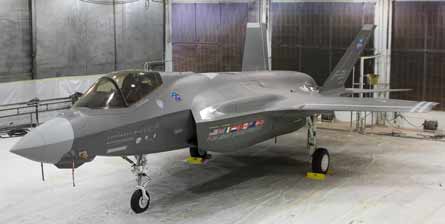Lockheed battles to safeguard F-35 production plans as Congress and services eye spending cuts
As if it was not difficult enough to develop a new fighter, it seems that getting it into production is becoming harder. Even as ground runs begin on the first F-35 Lightning II, Lockheed Martin is fighting moves in the US Congress to slow production of the Joint Strike Fighter (JSF) to provide near-term defence budget relief.
Congress is concerned about the overlap, or concurrency, between development and production of the JSF, given the complexity of building and testing three versions - conventional take-off and landing (CTOL), short take-off and vertical landing (STOVL) and carrier variant (CV) - during the system development and demonstration (SDD) phase. At the same time, some in Congress want to find money for a competitive engine from within the existing budget, adding pressure on development and production funding.
|
|---|
| Lockheed argues that low-rate initial production of the JSF would drive up costs |
Concurrency was designed into the programme because all three US services and the first international customers want initial operational capability (IOC) at about the same time, says Tom Burbage, Lockheed executive vice-president and general manager, F-35 programme integration. The IOCs are 2012 for the US Marine Corps' F-35B STOVL aircraft, 2013 for the US Air Force's F-35A CTOL and US Navy's F-35C CV variants and 2014 for the UK. But these could change - reports quoting internal budget planning documents say the USN and USMC want to delay fielding their JSFs for more than a year to save money.
Congress wants to reduce concurrency by delaying or slowing low-rate initial production (LRIP), the phase when the aircraft's design and manufacturing processes are stabilised ready for full-rate production. The JSF has a more aggressive ramp-up during LRIP than previous fighter programmes as it has to meet the needs of multiple customers. Beginning in Lot 1, the present plan adds a variant each year while also stepping up deliveries to each customer. This results in the rapid build-up from five CTOL aircraft in Lot 1 to 50 JSFs across all three variants by Lot 3.
"There was always more concurrency than in legacy programmes because of the challenge of producing aircraft for all three services and international partners at the same time. Because of that, the government made a significant investment upfront in risk reduction," says Burbage. The LRIP ramp rate has been slowed twice since award of the SDD contract in 2001, he says: in 2002 when the USN and USMC integrated their fleets and cut the overall number of aircraft required and in 2005, after a redesign to reduce weight delayed the programme by a year.
Congress justifies delaying the JSF by pointing out that Lockheed is three months behind the revised schedule. Burbage says the delay is in manufacturing a through-deck bulkhead introduced when the redesign changed the way the wing mates to the fuselage. Machining the 150kg (300lb) bulkhead from a 2,300kg ingot exceeded the supplier's tooling capacity, but Lockheed and its supplier have invested in additional bulkhead machining and wing assembly tools and "plan to be back on track by half-way through SDD, and well before LRIP", he says.
Lockheed is working to convince Congress that the industrial infrastructure for JSF would be disrupted, driving up costs, if it cuts too deeply into LRIP. The crucial metric for the supply chain, says Burbage, is not the number of aircraft procured in each fiscal year, but the number of production starts in each calendar year. Under the current programme, production begins on 10 aircraft this year - "They are already in flow," says Burbage - 13 in 2007 and 17 in 2008. The big step in rate comes in 2009, when production starts on the 50 aircraft in LRIP 3.
Under the differing mark-ups of the FY07 budget prepared by Congressional committees, that 10/13/17 ramp could be reduced to 10/12/9 if LRIP is slowed, or 10/9/5 if it is delayed. There is "no way" the industrial infrastructure can ramp up from five starts in 2008 to 50 in 2009, says Burbage, explaining: "The best any manufacturing industry can do is step up rate by 2.5 times year-on-year." Slowing production in LRIP, rather than increasing it from the one-a-month rate reached at the end of SDD, will disrupt the supply chain and drive up costs, Lockheed says.
If cuts are inevitable, the company argues, then the least costly option is to keep production at one a month for the first two years of LRIP, which could be achieved with the procurement of four CTOLs in Lot 1, and six CTOLs and six STOVLs in Lot 2. Production could then be ramped up in Lot 3 to 15 CTOLs and 15 STOVLs, plus the USN's first six CVs, for a minimum of 36 aircraft. This would reduce production over the first three years by 19 aircraft to 52, to which would be added any initial F-35s for international customers.
The potential for disruption to JSF production comes as the programme's eight international partners - Australia, Canada, Denmark, Italy, the Netherlands, Norway, Turkey and the UK - go through the national approval processes needed to participate in the production, sustainment and follow-on development phase. The window for signing a multinational memorandum of understanding is from 1 November-31 December.
Source: Flight International




















